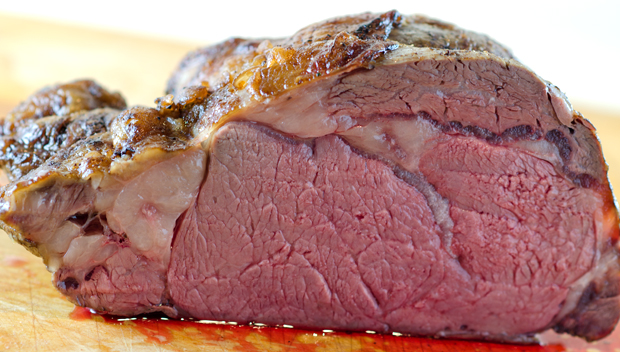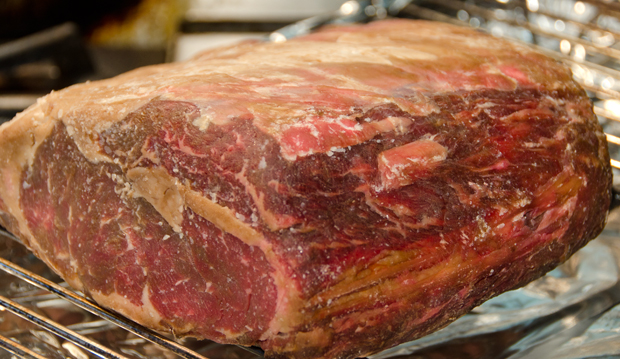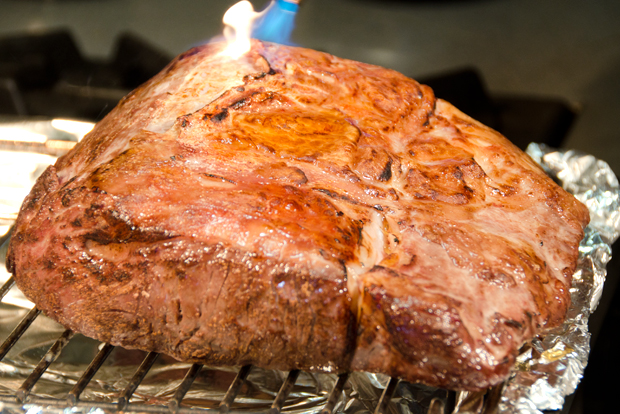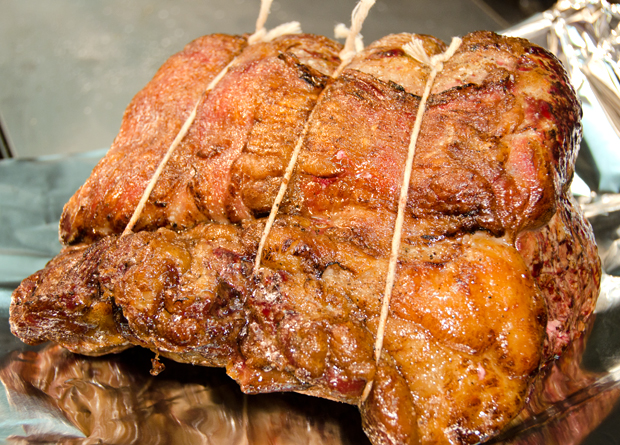 A prime rib roast is a welcome centerpiece to the dinner table, a culinary highlight of the holiday season. Improper treatment of that piece of meat will waste your money, produce dry unappetizing meat and leave you and your guests disappointed. So let’s go over the steps for the perfect prime rib.
A prime rib roast is a welcome centerpiece to the dinner table, a culinary highlight of the holiday season. Improper treatment of that piece of meat will waste your money, produce dry unappetizing meat and leave you and your guests disappointed. So let’s go over the steps for the perfect prime rib.
First things first, what makes a prime rib prime? The entire rib section of the animal, ribs six through twelve, is known by butchers as a primal cut. A prime rib roast can consist of anywhere from two to seven ribs. Many butchers will cut the prime rib, also known as a standing rib roast into two cuts. Ribs ten through twelve is the narrower end, also known as the loin end or the first cut. Ribs 6 through 9 is the chuck end or the second cut.
Prime rib does not mean that your roast is USDA prime. In fact, it probably isn’t, most prime meat is reserved for high end restaurants and upscale markets. The prime rib you will find at your supermarket will either be graded choice or select. The higher the grade of meat, the more marbling of fat. As always, fat equals flavor and that tenderizes the meat.
I purchase my bone-in roast with the bones cut off but tied back on the roast. Tying the roast makes for a more attractive presentation and keeps the outer flap of meat from overcooking. Bones off makes for easier carving, but the bones add flavor to the au jus that accompanies the roast. Enjoy the beef spare ribs as a chef’s treat the next day. Figure on about a pound of bone in meat per person if prime rib is your only entree.
Steak houses cook their prime rib low and slow in a 120°F degree oven to achieve consistently rosy meat from the center to the outer edges. Since no household oven I know of has a setting that low, we have been using the method for cooking prime rib from Cooks Illustrated magazine for many years with good results.
Now that you have that roast home, first step, up to four days before you cook the prime rib, liberally season the meat with salt. Let the meat sit uncovered in the refrigerator. Salting ahead allows the salt to penetrate the meat, break down some of the proteins and not just flavor the surface of the meat. The day you plan on cooking your roast, bring your roast out of the refrigerator several hours ahead so that the meat comes to room temperature. Preheat your oven to 200°F, place a rack in the lowest setting, of course you checked your oven ahead to be certain it can hold this large piece of meat.
To achieve the dark caramelized exterior that makes a fabulous prime rib Cooks Illustrated instructs you to sear all the edges of the meat in a pan on the stovetop before putting it in the oven. Effective but a little cumbersome and you dirty an extra pan. We used this method for years until we learned a tip from Thomas Keller in his cookbook, Ad Hoc. He browns the outside of his prime rib with a propane torch, not one of those little torches they sell in kitchen stores for crème brulee (yes I have one) a real propane torch. The torch gives you a way to control the flame and start a beautiful crust. Place the roast on a rack in pan you plan to cook it in. Sear the meat until the fat begins to render and turn brown, The oven will continue to cook your meat and render the fat. The big torch works great also when you are serving crème brulee as well.
Season your meat with freshly ground pepper and place it in the preheated oven. We start checking the internal temperature of the meat at the 2 1/2 hour point. Look for an internal temperature of 120°F for rare and 125°F for medium rare. It is very important to have a well calibrated thermometer, we rely on our thermapen instant read for accurate results. Meat cooked at higher temperatures will continue to cook and rise in temperature after they are removed from the oven. Since this recipe calls for cooking your roast at a low temperature, the rise in temperature of your roast when you remove it from the oven will be minimal.
Let your roast rest for about 20 minutes for the juices to redistribute. Transfer the meat and carve, serving with the juices. Have guests who don’t like pink meat? Quickly brown those slices in a sauté pan.

Perfect Prime Rib
Recipe adapted from Cooks Illustrated, Nov/Dec 95 and Nov/Dec 11 and Ad Hoc
Serves 6-8
Ingredients
- 1 (7-pound) first-cut beef standing rib roast (3 bones), meat removed from bones, bones reserved
- Kosher salt and freshly ground pepper
- 2 t vegetable oil
-
Using sharp knife, cut slits in surface layer of fat, spaced 1 inch apart, in crosshatch pattern, being careful to cut down to, but not into, meat. Rub 2 tablespoons salt over entire roast and into slits. Place meat back on bones (to save space in refrigerator), transfer to large plate, and refrigerate, uncovered, at least 24 hours and up to 96 hours.
2. Adjust oven rack to middle position and heat oven to 200 degrees. Heat oil in 12-inch skillet over high heat until just smoking. Sear sides and top of roast (reserving bone) until browned, 6 to 8 minutes total (do not sear side where roast was cut from bone). Alternately, place the roast fat side up on a rack in a roasting pan and sear the meat until the fat begins to render and turn gray. Place meat back on ribs, so bones fit where they were cut, and let cool for 10 minutes; tie meat to bones with 2 lengths of twine between ribs. Transfer roast, fat side up, to wire rack set in rimmed baking sheet and season with pepper. Roast until meat registers 110 degrees, 3 to 4 hours.
3. Turn off oven; leave roast in oven, insert a temperature probe in the roast at this time and quickly close the oven door, minimalizing heat loss is crucial. Set your probe for about 120 degrees for rare or about 125 degrees for medium-rare, 30 to 75 minutes longer.
4. Remove roast from oven (leave roast on baking sheet), tent loosely with aluminum foil, and let rest for at least 20 minutes.

